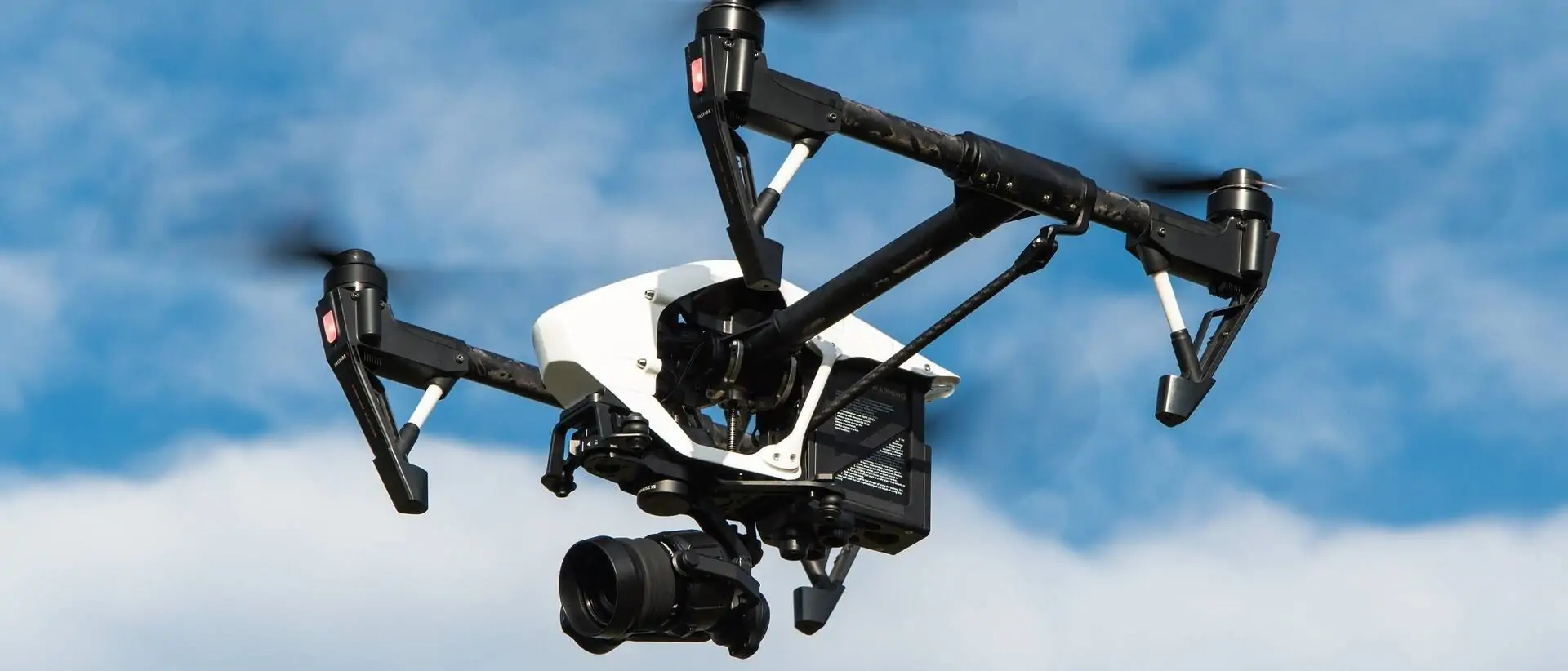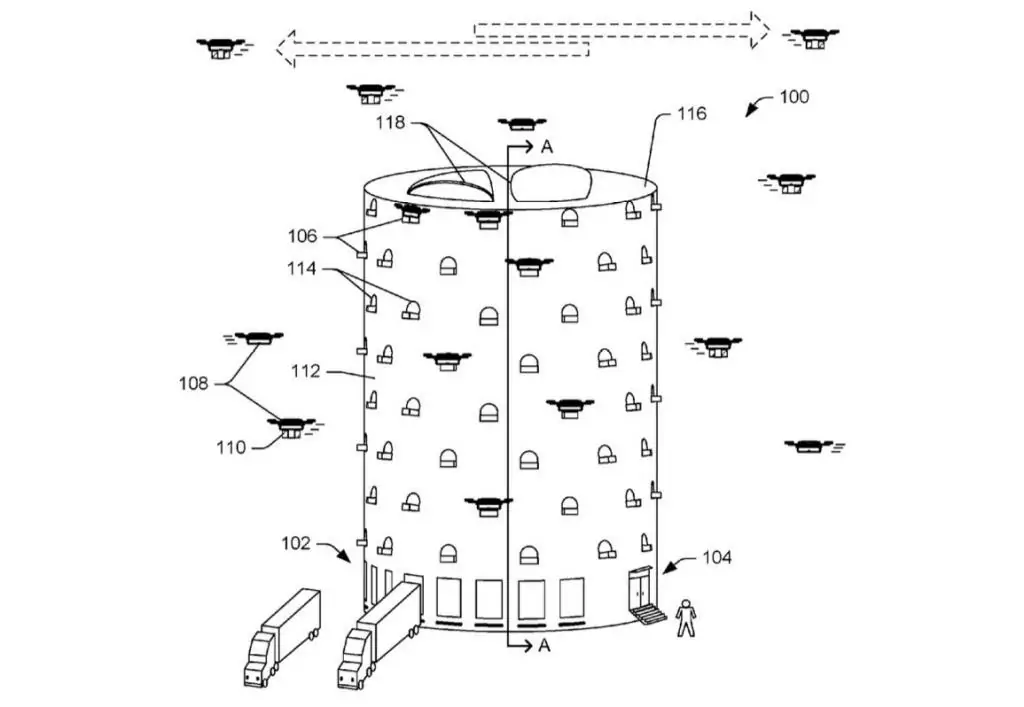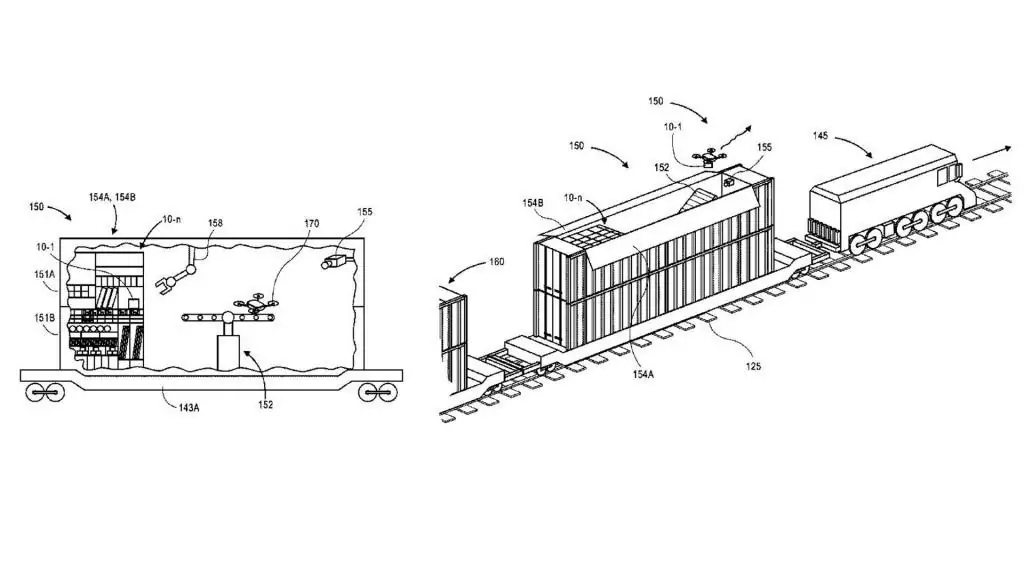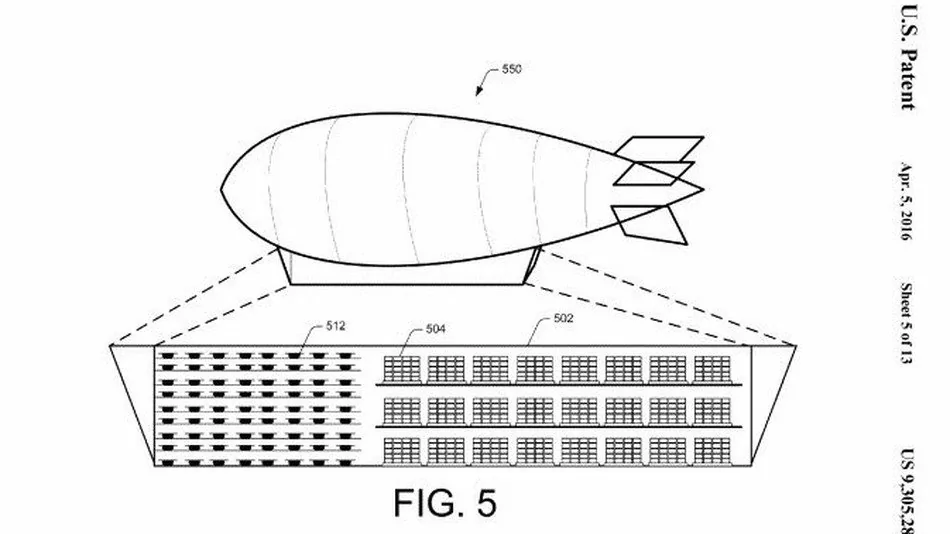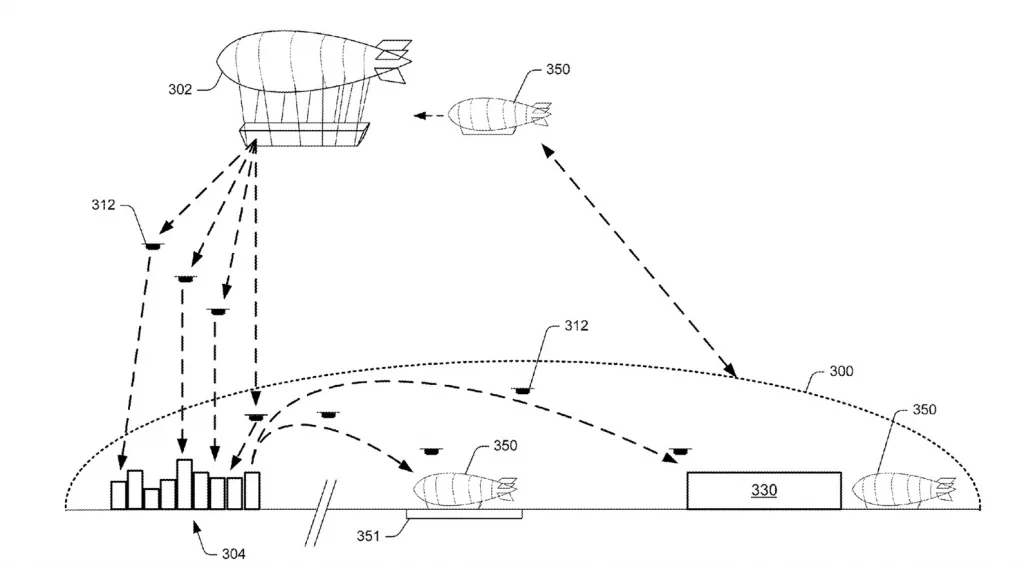Deliveries by automated or even autonomous drones? What we know at best as a vision from science fiction films could soon be part of our everyday lives. At least, if Amazon, UPS, Mercedes Benz and DHL have their way. What are the challenges, what is legally permitted in Germany – keyword airspace security? And what logistical approaches by service providers are already known? A summary.
Duocopter, tricopter, quadcopter, hexacopter and octocopter: all these drone variants fly – but these technical terms are not as widespread as the collective term “drone”. It generally covers all types of multicopters. The only difference is the number of propellers and engines used. Another term that is often heard in this context is ‘unmanned aerial vehicle’ (UAV). In contrast to the term ‘drone’, it excludes objects on water and on land. Another common term is Remotely Piloted Aircraft Systems (RPAS). These are explicitly aircraft that, unlike autonomous flying objects, do not take to the air without remote control (automated flight control).
- A duocopter has two horizontal rotors and engines (very rare).
- A tricopter has three horizontal rotors and engines (very rare).
- A quadcopter has four horizontal rotors and engines.
- A hexacopter has six horizontal rotors and motors.
- An octocopter has eight horizontal rotors and motors.
Multicopters and the laws of physics
The more mass you want to move, the more energy you need to apply. Since the energy for a flight comes from an energy store placed in the flying drone, which generally experiences a lack of space, you quickly reach its limits. More energy means that you have to use a larger and consequently heavier battery, which in turn increases the mass to be moved. If you use the drone to transport goods, you also have to consider the payload, which adds to the actual weight. There are currently three conceivable options:
- An additional compartment is attached to the bottom of the drone in which goods can be stored.
- A net is attached to the bottom of the drone in which the goods to be transported are placed.
- A bag is attached to the drone floor, which is delivered at the destination by parachute (see Amazon example).
Note: Flying drones with a payload of up to four kilograms can currently (2017) only achieve a flight time of 20-30 minutes.
Nevertheless, multicopters have a wide range of uses. They can be used for recreational purposes, purely for flying, filming and photography. Or they can be used in the professional sector. Flying drones have already established themselves in the following business areas.
- Research
- Forestry and agriculture
- Industrial maintenance
- Surveying / terrestrial surveying
- Protection of the population by police, fire brigade or THW
- Use in logistics (see test phases)
- Disaster protection
- Border protection
- Film industry
Legal situation in Germany
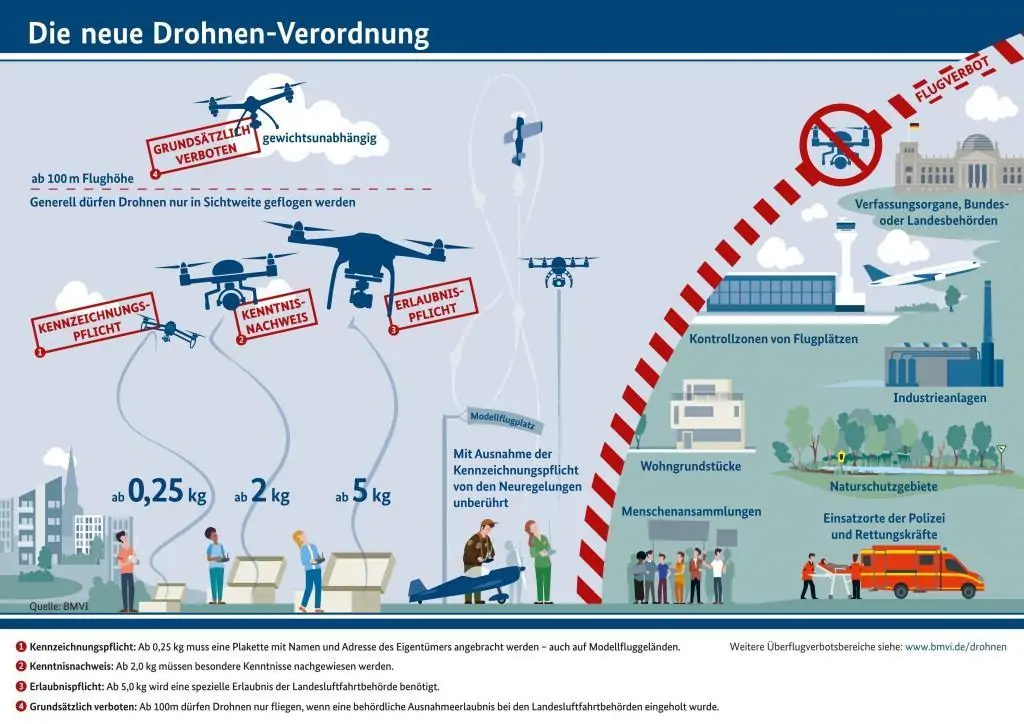
Key provisions: Drone regulation
1. Marking requirement: All model aircraft and unmanned aerial systems with a take-off weight of more than 0.25 kilograms must in future be marked so that the owner can be quickly identified in the event of damage. The marking is done by means of a sticker with the owner’s name and address.
2. Proof of knowledge: In future, a proof of knowledge will be required to operate model aircraft and unmanned aerial systems weighing two kilograms or more. Proof of knowledge is provided by a) a valid pilot license, b) a certificate issued after an examination by an agency recognized by the German Federal Aviation Office (online examination also possible), minimum age: 16 years c) a certificate issued after instruction by an aviation club (applies only to model aircraft), minimum age 14 years. The certificates are valid for five years. No proof of knowledge is required for operation on model aircraft grounds.
3. Exemption from licensing: In general, no license is required for the operation of model aircraft and unmanned aerial systems with a total mass of less than five kilograms. Such operations by public authorities are generally exempt from licensing if they are carried out in the performance of their duties, as are operations by organizations with security responsibilities, such as fire departments, the Federal Agency for Technical Relief (THW), the German Red Cross (DRK), etc.
4. Licensing requirement: A permit is required to operate model aircraft and unmanned aerial systems weighing more than five kilograms, and to operate them at night. This is issued by the state aviation authorities.
5. Opportunities for future technology: Until now, commercial users needed a permit to operate unmanned aerial systems, regardless of their weight. In the future, a permit will generally no longer be required to operate unmanned aerial systems weighing less than five kilograms. In addition, the existing general ban on operations beyond visual range will be lifted. In the future, state aviation authorities will be able to allow this for devices weighing five kilograms or more.
6. Operating ban: In the future, a ban on operation will apply to model aircraft and unmanned aerial systems
- beyond visual range for devices weighing less than five kilograms;
- in and over sensitive areas, such as police and rescue operations, hospitals, gatherings of people, facilities and institutions such as jails or industrial plants, supreme and upper federal or state authorities, nature reserves;
- over certain traffic routes;
- in control zones of airports (including airport approach and departure areas);
- at altitudes of more than 100 meters above ground, unless the operation takes place on a site for which a general permit has been issued for the ascent of model aircraft and for which a supervisor has been appointed, or, as long as it is not a multicopter, the controller holds a valid aircraft pilot license or has a certificate of knowledge;
- over residential properties, if the take-off mass of the device is more than 0.25 kilograms or the device or its equipment is capable of receiving, transmitting or recording optical, acoustic or radio signals. Exception: the person whose rights are affected by the operation over the respective residential property expressly consents to the overflight;
- over 25 kilograms (applies only to ‘unmanned aircraft systems’).
7. Right of way: unmanned aircraft systems and model aircraft are obliged to give way to manned aircraft and unmanned free balloons.
8. Use of video glasses: Flights using video glasses are permitted if they take place at altitudes of up to 30 meters and the device weighs no more than 0.25 kilograms or if another person is constantly monitoring it within sight and is able to alert the controller to any hazards. This is considered to be operation within the controller’s line of sight.
Important: The competent authority may grant exemptions from the prohibitions if the operation does not pose a risk to aviation safety or to public safety or order, in particular a violation of the regulations on data protection and nature conservation, and protection against aircraft noise is adequately taken into account. In particular, in the case of a planned operation outside the range of vision, the licensing authority requires an objective safety assessment to be submitted.
The regulation was promulgated in the Federal Law Gazette on April 6, 2017 and came into force on April 7. The regulations regarding the labeling requirement and the obligation to present a certificate of knowledge will apply from October 1, 2017.
We do not believe that drones will be flying to our front doors or individual balconies in the near future, but rather in defined corridors, for example from the warehouse to the distribution center. The last mile will then still be covered by car or bicycle.
Jörg Lamprecht, CEO of Dedrone GmbH in Kassel
Drones in logistics practice
We are still a long way from mass delivery by aerial drone. Even if the idea behind it is relatively easy to implement: take a drone, attach a package to it and send it directly to the customer. The associated responsibility for the operator or CEP service provider is all the more significant. On the one hand, the legislator has to take legal account of the delivery of goods by multicopter in terms of air traffic control and help shape the necessary infrastructure. On the other hand, companies have to continuously develop the technology further. This also includes networking the available infrastructure, including legal security provisions (data protection, air traffic control, insurance cover for property and personal damage). A permanently costly undertaking. Nevertheless, some companies such as UPS, Amazon, DHL and Mercedes are already experimenting with flying objects.
UPS
For less densely populated areas, UPS has been working for some time on a solution that combines current transport solutions (vans) with flying drones. In the future, the transport vehicles are to be equipped with drones to save the driver detours. In February 2017, the first successful tests were reported: the driver of the van loaded the drone and it delivered the test packages autonomously to private households. After delivery, the drone returned to the vehicle independently while the delivery driver continued his route in the vicinity and delivered other parcels (see video). The maximum flight time is said to be 30 minutes. The load capacity is given as 4.5 kilograms. UPS claims that the additional support from the air has drastically reduced costly travel costs. According to the company, saving just one mile per delivery person per day over the course of a year can reduce costs by up to 42 million euros.
Amazon
Amazon is also very interested in delivering its inventory to customers by air, but it is pursuing a different approach. The goods are to be delivered directly from a ‘flying distribution center‘ to the customer. A patent shows futuristic-looking airships for this purpose, floating at an altitude of up to 13,700 meters above the ground. A swarm of drones will then quickly and accurately deliver the inventory to the customer. At least that’s the plan of the US company. However, there are also plans to launch drones directly from a ‘classic’ distribution center – in the middle of a city. In addition, a concept is known in which Amazon, similar to UPS, uses a classic means of transport as a base: the train (see patent illustration). The service will not be limited to consumer goods. Amazon plans to use drones to deliver food or even ready-made meals.
The Amazon distribution center of the future: delivery will be by drone. (Image: Amazon)
Another patent shows the delivery from a rail vehicle. The distribution center and drones are embedded in the wagon. (Image: Amazon)
The most promising version for the future: the flying warehouse. Drones and goods are planned to be transported hanging underneath the flying object. (Image: Amazon)
The flying airships, including the distribution center, will hover at a height of almost 13 kilometers. (Image: Amazon)
Even if the airships are still a long way off, drone delivery without a mother ship has long been an issue for the US company. Amazon’s ‘Prime Air‘ drones are expected to cover the last mile to the customer before the airships. What makes Amazon’s drones special is that, according to the company, they will consume significantly less energy than conventional drones. The delivery drones simply drop the package over the destination; the inventory hangs on a parachute. This method of delivery means that fewer take-offs and landings are needed.
DHL
In Germany, too, work is already underway on delivery using flying objects. DHL has been researching the ‘Paketkopter’ since 2013 and has since presented its results in a very transparent manner. DHL is initially focusing on areas that are difficult to access, such as the North Sea islands or locations that are difficult to access due to mountain ranges. The latter test phase was realized and successfully tested in 2016 by means of a specially developed parcel station, the Parcelcopter SkyPort (see video).
- Private customers were able to notify their delivery at the Winklmoosalm during a three-month test phase by placing the items in the Skyport.
- The Parcelcopter inside the Skyport automatically took over the shipment (see video) and delivered it autonomously to the recipient.
A total of 130 autonomous loading and unloading operations were carried out during the project period. In the process, 500 meters of altitude were covered per route and a distance of eight kilometers was covered from the valley to the alpine hut. The payload was up to two kilograms and the cruising speed is given as 70 kilometers per hour (see graphic).
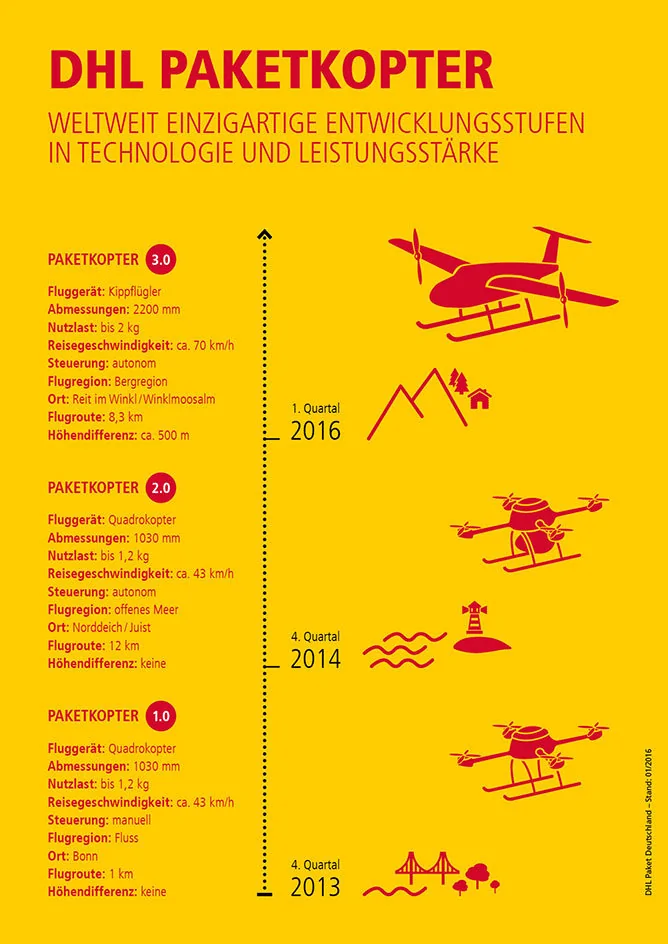
It is worth mentioning the development stages of the three pilot projects. In 2013 and 2014, the payload was still limited to 1.2 kilograms. In 2016, two kilograms could already be transported. In addition, in the beginning, only a top speed of 43 kilometers per hour was achieved (in 2016, as mentioned, it was 70 kilometers per hour). It should be mentioned that a quadcopter was used in 2013 and 2014; since 2016, DHL has been relying on a tiltwing aircraft. This has a wingspan of almost two meters, a length of 2.2 meters and weighs 14 kilograms without goods. Of course, a conventional quadcopter cannot keep up with that. The special feature of the tiltwing aircraft is the wings, which are tilted around the aircraft’s lateral axis for take-off and landing in order to change the direction of thrust of the two electric engines.
Mercedes Benz
The carmaker Mercedes Benz is also testing the use of its vans paired with drone technology. On the one hand, it has been working with the US company Matternet for quite some time (see video), and on the other hand, it has been developing a van study for urban areas with the ‘Vision Van’ project since 2016, which seems to be several years ahead of previous projects. The reason: “The ‘Vision Van’ connects numerous technologies and becomes the central, intelligent element in a fully connected delivery chain. Novel algorithms control the picking and loading of packages, the fully automated loading space management, and the route planning for the vehicle and the delivery drones,” according to the company. The vehicle not only transports inventory; it also has its own mini-high-bay warehouse inside (see picture).
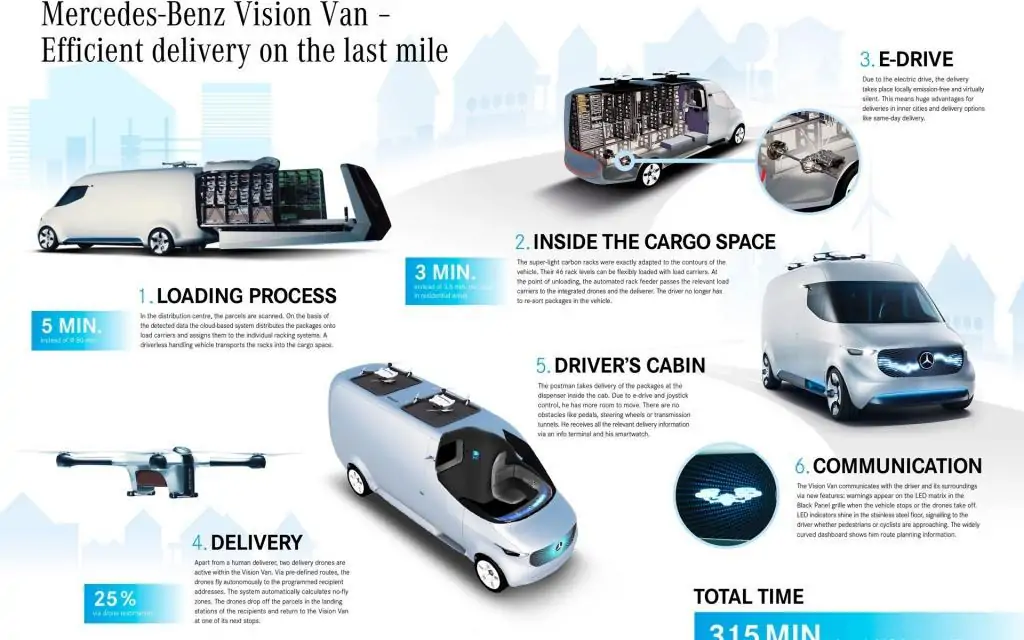
Drone base vs. decentralized hubs
The best transport drone is useless if it can’t transport anything. In the traditional transportation industry, centralized or decentralized distribution centers have been used for a long time. Smaller hubs, where inventory can be stored decentrally, are also being considered more and more often in companies’ logistics planning.
If you consider the flight times of the individual drones mentioned above, a centralized distribution center makes little sense in terms of logistics infrastructure. The extent to which a decentralized warehouse appears more useful is currently being tested in field trials (see examples) by many CEP service providers and large corporations (Amazon, Mercedes Benz). Regardless of whether a central drone base or decentralized hubs are used, a corresponding delivery area will only have a small radius in the future as well. In addition to the insufficient battery power of the flying drones, the supply chain must also be rethought in completely new processes. Whether this type of logistics is also suitable for metropolitan areas must be clarified by courts of law: air traffic control, insurance protection, the human factor, the current legal situation (see legal situation) and, of course, the lack of infrastructure are important points to be mentioned.
Conclusion: customer delivery by air: the future of logistics?
Today, delivery vehicles for CEP service providers clog entire streets because they are forced to park in the second row. In large cities, the congestion is often so great that it is not uncommon for suppliers to block themselves. This development is exacerbated by customers demanding ever faster deliveries. However, a redistribution of delivery orders that can be taken over by drones only makes sense for certain inventories.
Nevertheless, the advantages of aerial delivery are obvious: parcel drones are not dependent on the road network. Natural barriers are no obstacle for them. With more effort, urban areas could also be served. Transport drones allow a decoupling from the classic transportation network and centralized logistics, the consequences of which we can only guess at the moment. Ultimately, in some cases, roads and railways will no longer be necessary. Nevertheless, drone delivery is certainly not suitable for all goods. However, especially urgently needed inventories such as medicines, food and clothing in areas that are difficult to access or in rural areas in general can be delivered better and faster via drone.
New smart concepts will soon determine how drone technology is integrated into the prevailing traffic flows. In the future, company data centers will evaluate the collected data on traffic density, weather conditions and environmental pollution. Some of the information will come from the drones themselves – from the sensors and cameras installed on them. And with the connected infrastructure and the appropriate drone concept, companies like Amazon, DHL, UPS and Mercedes Benz may be able to reduce daily urban traffic congestion caused by CEP service providers.
This article was produced in editorial collaboration with Torsten Schmitt. Schmitt, aka @Pixelaffe, refers to himself as ‘Ge.rd’ – half geek, half nerd. He works as a developer, project manager, blogger and consultant, and has been the ‘chief pilot’ at Dronecamp since 2015. He also writes for his own blog, Pixelaffe.
